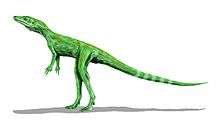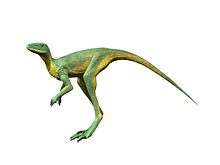Lagerpetidae
The Lagerpetidae (/ˌlædʒərˈpɛtɪdiː/; originally Lagerpetonidae) is a family of basal avemetatarsalians often considered the earliest-diverging dinosauromorphs. Lagerpetid fossils are known from Late Triassic of Argentina, Arizona, Brazil, Madagascar, New Mexico, and Texas.[1][2][3][4][5] They were typically small, although some lagerpetids, like Dromomeron gigas and an unnamed taxon from the Santa Rosa Formation, were able to get quite large.[6][7] Their fossils are rare; the most common finds are bones of the hindlimbs, which possessed a number of unique features.[8]
| Lagerpetidae | |
|---|---|
 | |
| Life restoration of Dromomeron gregorii | |
| Scientific classification | |
| Kingdom: | Animalia |
| Phylum: | Chordata |
| Clade: | Dinosauromorpha (?) |
| Family: | †Lagerpetidae Arcucci, 1986 |
| Genera | |
Description
As with most early dinosauromorphs, the most characteristic adaptations of lagerpetids occurred in their hip, leg and ankle bones, likely as a result of these being the bones most commonly preserved. Hip material is only known in Lagerpeton and Ixalerpeton, which share three adaptations of the ilium (upper blade of the hip). The supraacetabular crest, a ridge of bone which lies above the acetabulum (hip socket), is thickest above the middle portion of the acetabulum, rather than the front of it. However, it also extends further forwards than in most dinosauromorphs, snaking along the length of the pubic peduncle (the area of the ilium which connects to the pubis). The ilium's facet for the pubis opens downwards, a trait also acquired by ornithischian dinosaurs.[3] The hip in general was wide, had a closed acetabulum (i.e. one with a bony inner wall), and had two sacral vertebrae, lacking many specializations of later dinosauromorphs, like dinosaurs.[1]

Like other early archosaurs (and archosaur relatives such as Euparkeria), the femur (thigh bone) was slender and S-shaped. The femoral head was thin when seen from above, and its apex projected about 45 degrees between medially (inwards) and anteriorly (forwards). Most archosaurs had three tubera (bumps) on their flattened femoral head, one at the middle of the anterolateral (forwards/outwards) surface, another at the middle of the posteromedial (backwards/inwards) surface, and a small third one which was near the apex of the femoral head. However, lagerpetids lack the anterolateral tuber, instead having an emargination in the head just below where the tuber would normally be expected. The femoral head itself was notably hook-shaped when seen from the side. The distal portion of the femur (i.e. the portion near the knee) had a pair of condyles (knobs) on either side of the rear surface, as well as a third knob-like structure known as a crista tibiofibularis, which was present just above the lateral condyle. The crista tibiofibularis was uniquely enlarged in lagerpetids, and undergoes further evolution in Ixalerpeton and particularly Dromomeron.[8]
The tibia and fibula (shin bones) were long and thin, with the tibia longer than the femur and generally resembling the tibia of early theropod dinosaurs.[3] The ankle was formed by two main bones: the astragalus (which contacts both the tibia and fibula), and the calcaneum (which only contacts the fibula). As with other dinosauromorphs, the astragalus was twice as wide as the reduced calcaneum. In addition, the two bones were co-ossified (fused together), akin to the condition in pterosaurs and some early dinosaurs (coelophysoids, for example). A pair of small, pyramid-shaped structures rise up out of the astragalus, one in front of the facet for the tibia, and the other behind it. The one in front is similar to a structure found in dinosauriform ankles known as the anterior ascending process, and it may be homologous with it. However, the posterior ascending process (the one behind the tibial facet) is entirely unique to lagerpetids. The rear of the astragalus lacks a horizontal groove, similar to Tropidosuchus, theropods, and ornithischians, but unlike most other archosauriforms. Like pterosaurs and dinosaurs (but unlike Marasuchus and most other archosaurs), the facet on the calcaneum which receives the fibula is concave and there is no evidence of a pronounced rearward bump known as a calcaneal tuber.[8][3]
Classification
The lagerpetids are typically considered relatives of the dinosaurs, as a branch of the group Dinosauromorpha. The family was originally named Lagerpetonidae by Arcucci in 1986,[1] though it was later renamed Lagerpetidae in a phylogenetic study by S. J. Nesbitt and colleagues in 2009. A clade of lagerpetids was also recovered in the large phylogenetic analyses of early dinosaurs and other dinosauromorphs that were produced by Baron, Norman & Barrett (2017).[9] More recently, Muller et al. (2018) carried out the most comprehensive study on lagerpetid phylogeny, which assembled all lagerpetid specimens, taxa and morphotypes known so far into three of the most recent data matrices on early dinosauromorph/archosaur evolution.[10] Finally, Garcia et al. (2019) added an unnamed lagerpetid (a new morphotype) to the data matrices used in the study by Muller et al. (2018).[4]
Cladogram simplified after Cabreira et al., 2016:[3]
| Eucrocopoda |
| ||||||||||||||||||||||||||||||||||||||||||
References
- Arcucci, Andrea (1986). "New materials and reinterpretation of Lagerpeton chanarensis Romer (Thecodontia, Lagerpetonidae nov.) from the Middle Triassic of La Rioja, Argentina" (PDF): 3. Retrieved 2010-04-28. Cite journal requires
|journal=(help) - Sterling J. Nesbitt; Julia Brenda Desojo; Randall B. Irmis, eds. (2013). Anatomy, Phylogeny and Palaeobiology of Early Archosaurs and Their Kin. The Geological Society of London. p. 164. ISBN 9781862393615. Retrieved 29 March 2016.
- Cabreira, S.F.; Kellner, A.W.A.; Dias-da-Silva, S.; da Silva, L.R.; Bronzati, M.; de Almeida Marsola, J.C.; Müller, R.T.; de Souza Bittencourt, J.; Batista, B.J.; Raugust, T.; Carrilho, R.; Brodt, A.; Langer, M.C. (2016). "A Unique Late Triassic Dinosauromorph Assemblage Reveals Dinosaur Ancestral Anatomy and Diet". Current Biology. 26 (22): 3090–3095. doi:10.1016/j.cub.2016.09.040. PMID 27839975.
- Garcia, Maurício S.; Müller, Rodrigo T.; Da-Rosa, Átila A.S.; Dias-da-Silva, Sérgio (April 2019). "The oldest known co-occurrence of dinosaurs and their closest relatives: A new lagerpetid from a Carnian (Upper Triassic) bed of Brazil with implications for dinosauromorph biostratigraphy, early diversification and biogeography". Journal of South American Earth Sciences. 91: 302–319. doi:10.1016/j.jsames.2019.02.005.
- Kammerer, Christian F.; Nesbitt, Sterling J.; Flynn, John J.; Ranivoharimanana, Lovasoa; Wyss, André R. (2020-07-02). "A tiny ornithodiran archosaur from the Triassic of Madagascar and the role of miniaturization in dinosaur and pterosaur ancestry". Proceedings of the National Academy of Sciences. doi:10.1073/pnas.1916631117. ISSN 0027-8424.
- Ricardo N. Martínez; Cecilia Apaldetti; Gustavo A. Correa; Diego Abelín (2016). "A Norian lagerpetid dinosauromorph from the Quebrada del Barro Formation, northwestern Argentina". Ameghiniana. 53 (1): 1–13. doi:10.5710/AMGH.21.06.2015.2894.
- Beyl, Alexander; Nesbitt, Sterling; Stocker, Michelle R. (2020-07-07). "An Otischalkian dinosauromorph assemblage from the Los Esteros Member (Santa Rosa Formation) of New Mexico and its implications for biochronology and lagerpetid body size". Journal of Vertebrate Paleontology. 0 (0): e1765788. doi:10.1080/02724634.2020.1765788. ISSN 0272-4634.
- Nesbitt, S.J. (2011). "The Early Evolution of Archosaurs: Relationships and the Origin of Major Clades" (PDF). Bulletin of the American Museum of Natural History. 352: 189. doi:10.1206/352.1. hdl:2246/6112. ISSN 0003-0090.
- Baron, M.G.; Norman, D.B.; Barrett, P.M. (2017). "A new hypothesis of dinosaur relationships and early dinosaur evolution" (PDF). Nature. 543 (7646): 501–506. doi:10.1038/nature21700. PMID 28332513.
- Müller, Rodrigo Temp; Langer, Max Cardoso; Dias-Da-Silva, Sérgio (2018-03-07). "Ingroup relationships of Lagerpetidae (Avemetatarsalia: Dinosauromorpha): a further phylogenetic investigation on the understanding of dinosaur relatives". Zootaxa. 4392 (1): 149–158. doi:10.11646/zootaxa.4392.1.7. ISSN 1175-5334. PMID 29690420.









